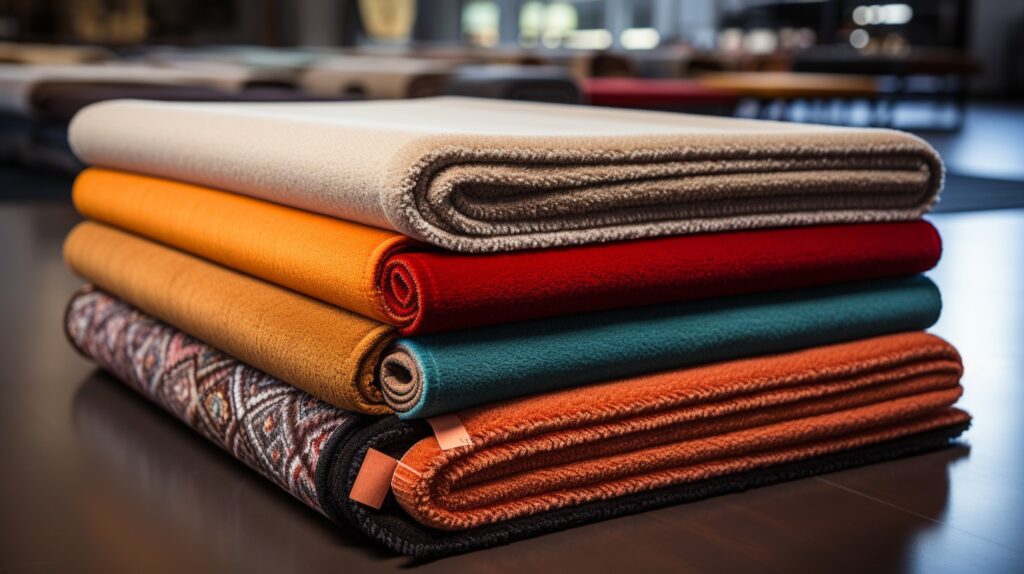
Introduction
When we consider the sanctity of our living spaces, the quality of the air we breathe commands paramount importance. It is the invisible sustenance of our everyday well-being, yet it can be sullied by the most seemingly benign of household features—our carpets. Beneath the lush fibers of the most luxurious carpets can lurk a cocktail of chemicals and allergens, affecting air quality and, consequently, our health. The carpet beneath your feet, a staple of comfort and a centerpiece of home decor could be playing a pivotal role in the air quality of your indoor environment.
The Composition of Carpets and Air Quality Concerns
Carpets are not just made from threads and weaves; their very composition is a complex amalgamation of materials and treatments. The base materials range from natural to synthetic fibers, each carrying its unique set of properties and potential impacts on indoor air quality.
Types of Carpet Materials
Natural fibers like wool, cotton, and jute have been used for centuries in carpet making. They are prized for their sustainability and lower propensity to off-gas harmful substances compared to their synthetic counterparts. Wool, especially, is heralded for its durability and natural resistance to stains and dust mites. However, even natural fibers can harbor allergens and require regular maintenance to prevent the accumulation of unwanted particulates.
On the other side of the spectrum are synthetic fibers such as nylon, polyester, and olefin. These man-made materials are celebrated for their resilience, color retention, and affordability. Nonetheless, they are often treated with a variety of chemicals to enhance their properties, which can be a source of indoor air pollution.
Chemical Treatments and Adhesives
The myriad of treatments applied to carpets for practical purposes—such as flame retardants, stain protectors, and adhesives for backing materials—can release volatile organic compounds (VOCs) into the air. These chemical treatments are necessary to meet safety and durability standards but can have unintended consequences for air quality.
Volatile Organic Compounds (VOCs) and New Carpeting
VOCs are a large group of chemicals that are found in many products we use to build and maintain our homes. When these chemicals are released into the indoor environment, they can contribute to a host of health issues, from headaches and dizziness to respiratory problems and even chronic health conditions over long-term exposure. New carpets, in particular, can emit these VOCs for weeks or even months after installation, a phenomenon known as “off-gassing.”
Understanding the lifecycle of these emissions is critical. Manufacturers are increasingly aware and have been working on reducing the VOC levels in their products. Nowadays, low-VOC options are available, which can significantly mitigate these concerns and contribute to healthier indoor air.
The Dynamics of Carpets as Air Filters
An often overlooked function of carpets is their ability to act as passive air filters. Carpets can trap dust, allergens, and other particulates, effectively removing them from the breathing zone. This attribute, however, is a double-edged sword.
Trapping Allergens and Particles
While trapping particulates, carpets can accumulate significant amounts of allergens like dust mites, pet dander, and pollen. The extent to which these allergens are trapped is influenced by the carpet’s pile height and density. A dense, tightly woven carpet can hold more allergens, which are then less likely to circulate in the air.
Microbial Growth in Carpets
The cozy fibers of carpets can also provide an ideal environment for microbial growth, particularly mold, and mildew, when exposed to moisture. Such growth can have severe repercussions for indoor air quality and health, triggering allergies and asthma in sensitive individuals. The stakes are higher in humid environments and places prone to spills and water damage.Carpet Maintenance and Air Quality

The maintenance of carpets is integral to preserving the air quality of indoor spaces. Regular vacuuming with HEPA-filter-equipped machines can effectively remove the accumulated particulates and mitigate the potential for allergen buildup.
Testing Air Quality
Homeowners and building managers can also employ air quality testing kits to assess the level of allergens and VOCs present. This proactive approach not only ensures the identification of potential air quality issues but also guides the necessary interventions to mitigate them.
Mitigation Strategies
Improving ventilation is a primary strategy for reducing the concentration of airborne chemicals and allergens. The use of dehumidifiers and air purifiers with HEPA filters can further aid in controlling air quality. When it comes to carpets themselves, choosing products with low VOC emissions and without harmful chemicals is a preventive measure.
Carpet Replacement Considerations
Eventually, carpets need to be replaced, and when that time comes, several factors should be taken into account. Age, wear, and the effectiveness of the carpet in trapping and holding particulates should guide the decision. Additionally, the environmental impact of carpet disposal and the selection of new, more sustainable options should be considered.
Standards and Certifications for Healthier Carpets
The carpet industry has made strides in reducing the potential negative impacts of carpets on indoor air quality. There are established standards and certifications that consumers can rely on when choosing their carpets.
Industry Standards for Low-Emission Carpets
Organizations such as the Carpet and Rug Institute (CRI) offer certifications like the Green Label Plus, which identifies carpets that emit the lowest levels of VOCs. Consumers looking for healthier indoor environments should look for these certifications when purchasing carpets.
Eco-friendly and Sustainable Options
The demand for sustainable living has brought eco-friendly carpets to the market. These options use natural or recycled materials, and their production processes are designed to have a minimal environmental footprint. Advances in technology have also introduced carpets that are both recyclable and biodegradable, signaling a new era of environmentally conscious carpet manufacturing.
Regulations and Consumer Advocacy
Regulations have been put in place in various jurisdictions to limit the levels of harmful emissions from carpets. Consumer advocacy groups also play a crucial role in promoting awareness and pushing for healthier, safer carpeting options. They are often at the forefront of demanding transparency and accountability from manufacturers regarding the health implications of their products.
Practical Tips for Homeowners and Building Managers
In the quest to ensure that carpets contribute positively to indoor air quality, there are several practical steps that homeowners and building managers can take.
Selecting the Right Carpet for Air Quality
Choosing the right carpet can be daunting, but for those particularly sensitive to allergens or chemicals, it is critical to opt for natural fibers and low-VOC products. Areas with high traffic or where children play may require carpets that are not only durable but also have a lower potential for allergen accumulation.
Maintenance Best Practices
Effective maintenance routines are the cornerstone of ensuring that carpets remain an asset to indoor air quality rather than a detriment. Regular vacuuming, immediate attention to spills, and periodic professional cleanings are all part of a robust maintenance regimen.
Innovations in Carpet Design and Maintenance
The carpet industry is not static; it evolves with emerging technologies. Innovations in fiber technology, weave patterns, and even in-built stain resistance are shaping the future of carpets. Similarly, advancements in carpet cleaning techniques and equipment are improving our ability to maintain carpets in a way that supports healthy indoor air.
In the exploration of carpets and indoor air quality, it becomes apparent that there is a complex interplay at work. Carpets can be both a blessing and a bane, but with informed choices and diligent care, we can ensure that the air within our homes remains a source of life and not distress. By understanding the materials, practices, and products available, we can all breathe a little easier.
Strategic Approach to Carpet Maintenance and Air Quality Enhancement
Maintaining a carpet in a manner that promotes good indoor air quality requires a strategic approach. It’s not just about vacuuming regularly, but also about knowing when and how to employ deeper cleaning techniques, as well as understanding the role of professional services.
Deep Cleaning Techniques
Over time, even with regular vacuuming, carpets can accumulate dirt and particulates that are not easily removed. This is where deep-cleaning techniques come into play. Steam cleaning, also known as hot water extraction, is one method that not only removes embedded dirt but can also kill dust mites and bacteria. Dry cleaning methods are also available, which use compounds that absorb dirt and are then vacuumed away.
The Importance of Professional Cleaning
While DIY methods can be effective for regular maintenance, there are times when professional cleaning is necessary. Professionals have access to more powerful equipment and specialized cleaning solutions that can provide a more thorough cleaning. This is particularly important in high-traffic areas or if someone in the household has allergies or asthma.Balancing Humidity and Carpet Care

Carpets can be sensitive to humidity. High humidity levels can encourage the growth of mold and mildew, while low humidity can cause carpets to dry out and become brittle. Using dehumidifiers or humidifiers to maintain a balanced indoor humidity level is essential in prolonging the life of a carpet and maintaining air quality.
Immediate Action on Spills
To prevent stains and the growth of bacteria, immediate action on spills is critical. A spill kit that includes clean white towels, water, and a gentle cleaning solution can address the most common spills. For more stubborn stains, there may be a need for specific cleaning agents, but these should be chosen carefully to avoid damaging the carpet or introducing harmful chemicals into the environment.
Innovative Products and Practices for Enhanced Carpet Longevity
The carpet industry is constantly innovating, creating products that not only last longer but also contribute to healthier indoor environments.
Carpet Padding and Air Quality
One area of innovation is carpet padding. Modern padding materials can now offer features such as antimicrobial properties, moisture barriers, and even odor-neutralizing technology. These advancements not only extend the life of the carpet but also support indoor air quality by preventing the growth of mold and mitigating unpleasant odors.
Sustainable Carpet Technologies
Sustainable technologies in carpet manufacturing are also on the rise. Carpets made from renewable materials with natural dyes are becoming more common. Additionally, some carpets are now designed to be fully recyclable, reducing their environmental impact once they have reached the end of their usable life.
Choosing the Right Carpet for Air Quality Optimization
When it comes time to replace a carpet or choose a new one, the decision should be made with air quality in mind.
Factors to Consider When Choosing a New Carpet
The choice of fiber is important; natural fibers may be preferable for those with sensitivities, but they also require more care. Synthetic fibers can be more resistant to mold and moisture, but they may emit VOCs. The pile and weave of the carpet also affect how much dirt and dust it can trap.
Navigating Certifications and Standards
Looking for certifications that guarantee low emissions can help in making an informed choice. The CRI’s Green Label Plus is one such certification, but there are also international standards like the Blue Angel or the Eco-Institut label that can guide consumers toward healthier options.
Seeking Expert Advice
Engaging with a knowledgeable salesperson or an interior designer who understands the health implications of different carpet choices can be invaluable. They can provide insights into which carpets are best suited for particular environments and usage patterns.
The Future of Carpets and Indoor Air Quality
Looking ahead, the relationship between carpets and indoor air quality is poised to become even more positive.
Technological Advancements in Carpet Production
Technological advancements promise carpets that are more durable, easier to clean, and made from materials that are even more conducive to good indoor air quality. Manufacturers are experimenting with natural and hybrid materials that offer the best of both worlds.
Integrated Solutions for Air Purification
There are emerging technologies that integrate air-purifying substances directly into the fibers of carpets. These substances can neutralize VOCs and other pollutants, turning carpets into active players in maintaining indoor air quality.
Conclusion
In conclusion, carpets hold a significant place in our indoor living spaces, not just as elements of decor but as influential factors in the quality of our indoor air. From selection to maintenance, the choices we make regarding our carpets can have far-reaching effects on our health and well-being. By staying informed and proactive, we can ensure that our carpets remain a source of comfort and not concern.